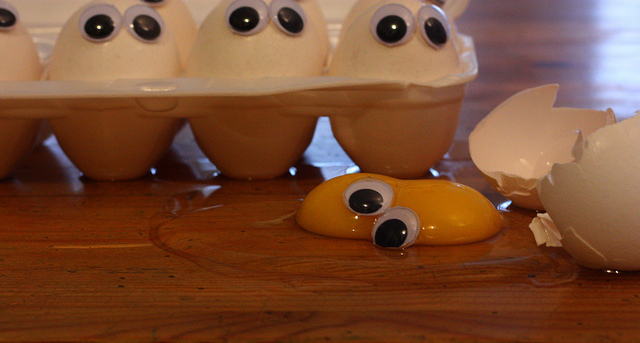Archive for the ‘Feelings’ Category
The Effective Expert
 What if you’re asked to do something you know isn’t right? Not from an ethical perspective, but from a well-read, well-practiced, world-thought-leader perspective? What if you know it’s a waste of time? What if you know it sets a dangerous precedent for doing the wrong work for the right reason? What if the person asking is in a position of power? What if you know they think they’re asking for the right work?
What if you’re asked to do something you know isn’t right? Not from an ethical perspective, but from a well-read, well-practiced, world-thought-leader perspective? What if you know it’s a waste of time? What if you know it sets a dangerous precedent for doing the wrong work for the right reason? What if the person asking is in a position of power? What if you know they think they’re asking for the right work?
Do you delay and make up false reasons for the lack of progress? Do you get angry because you expect people in power know what they’re doing? Does your anger cause you to double-down on delay? Or does it cause you to take a step back and regroup? Or do you give them what they ask for, knowing it will make it clear they don’t know what they’re doing?
What if you asked them why they want what they want? What if when you really listened you heard their request for help? What if you recognized they weren’t comfortable confiding in you and that’s why they didn’t tell you they needed your help? What if you could see they did not know how to ask? What if you realized you could help? What if you realized you wanted to help?
What if you honored their request and took an approach that got the right work done? What if you used their words as the premise and used your knowledge and kindness to twist the work into what it should be? What if you realized they gave you a compliment when they asked you to do the work? Better still, what if you realized you were the only person who could help and you felt good about your realization?
As subject matter experts, it’s in our best interest to have an open mind and an open heart. Sure, it’s important to hang onto our knowledge, but it’s also important to let go our strong desire to be right and do all we can to improve effectiveness.
If we are so confident in our knowledge, shouldn’t it be relatively easy to give others the benefit of the doubt and be respectful of the possibility there may be a deeper fundamental behind the request for the “wrong work”?
As subject matter experts, our toughest job is to realize we don’t always see the whole picture and things aren’t always as they seem. And to remain open, it’s helpful to remember we became experts by doing things wrong. And to prioritize effectiveness, until proven otherwise, it’s helpful to assume everyone has good intentions.
Image credit — Ingrid Taylar
Responding With Kindness
 If some talks to you in an angry way, what do you do? Well, if it’s a family member you take it personally and respond with equal and opposite anger. If it’s someone at work, you take it personally but use a bit more restraint. And in both cases, the root of all the trouble is taking their anger personally.
If some talks to you in an angry way, what do you do? Well, if it’s a family member you take it personally and respond with equal and opposite anger. If it’s someone at work, you take it personally but use a bit more restraint. And in both cases, the root of all the trouble is taking their anger personally.
There can be no argument if the second doesn’t accept the radiated negativity of the first. In that way, arguments are like tennis – it takes two to play a match worth watching. But in the heat of the moment, and even in the residual heat after the moment, it’s tremendously difficult remember their anger is about them.
The natural tendency is to focus on the injustice of the other’s anger. They’re out of line, they’re wrong, they shouldn’t yell like that. But pouring your energy into that bucket won’t end the arguments. You can’t control their behavior, you can only control your response to their behavior. The only way to end the arguments is to look inside and figure out why you take their anger personally.
If their anger threatens you, you’ll take it personally and respond in-kind. And what is threatened is your image of yourself. If you don’t think highly of yourself, you call your caliber into question and respond with anger to prop up and protect your self-image. But, if you don’t think their rage applies, you won’t be threatened and you’ll respond effectively. And you’ll be able to help them be more effective.
When you respond to anger with kindness, people notice. It may take them a while to understand there is no hidden agenda and your kindness truly kindness, but when they do, they change and your relationship changes. Trust and mutual respect blossom and the future has no limit.
It’s not easy to respond to anger with kindness. But in the end, it’s worth it.
Image credit – Dean Hochman
Transcending Our Financial Accounting Systems
 In business and in life, one of the biggest choices is what to do next. Sounds simple, but it’s not.
In business and in life, one of the biggest choices is what to do next. Sounds simple, but it’s not.
The decision has many facets and drives many questions, for example: Does it fit with core competence? Does it fit with the brand? How many will we sell? What will the market look like after it’s launched? Do we have what it takes to pull it off?
These questions then explode into a series of complex financial analyses like – return on investment, return on capital, return on net assets (and all its flavors) and all sorts of yet-to-be created return on this’s and that’s. This return business is all about the golden ratio – how much will we make relative to how much it costs. All the calculations, regardless of their name, are variations on this theme. And all suffer the same fundamental flaw – they are based on an artificial system of financial accounting.
To me, especially when working in new territory, we must transcend the self-made biases and limitations of GAAP and ask the bedrock question – Is it worth it?
In the house of cards of our financial accounting, worth equals dollars. Nothing more, nothing less. And this simplistic, formulaic characterization has devastating consequence. Worth is broader than profit, it’s nuanced, it’s philosophical, it’s about people, it’s about planet. Yet we let our accounting systems lead us around by the nose as if people don’t matter, like the planet doesn’t matter, like what we stand for doesn’t matter. Simply put, worth is not dollars.
The single-most troubling artifact of our accounting systems is its unnatural bias toward immediacy. How much will we make next year? How about next quarter? What will we spend next month? If we push out the expense by a month how much will we save? What will it do to this quarter’s stock price? It’s like the work has no validity unless the return on investment isn’t measured in days, weeks or months. It seems the only work that makes it through the financial analysis gauntlet is work that costs nothing and returns almost nothing. Under the thumb of financial accounting, projects are small in scope, smaller in resource demands and predictable in time. This is a recipe for minimalist improvement and incrementalism.
What about the people doing the work? Why aren’t we concerned they can’t pay their mortgages? Why do we think it’s okay to demand they work weekends? Why don’t we hold their insurance co-pays at reasonable levels? Why do we think it’s okay to slash our investment in their development? What about their self-worth? Just because we can’t measure it in a financial sense, don’t we think it’s a liability to foster disenchantment and disengagement? If we considered our people an asset in a financial accounting sense, wouldn’t we invest in them to protect their output? Why do we preventive maintenance on our machines but not our people?
When doing innovative work, our financial accounting systems fail us. These systems were designed in an era when it was best to increase the maturity of immature systems. But now that our systems are mature, and our objective is to obsolete them, our ancient financial accounting systems hinder more than help. The domains of reinvention and disruption are dominated by judgement, not rigid accounting rules. Innovation is the domain of incomplete data and uncertain outcomes and not the domain of debits and credits.
Profit is important, but profit is a result. Financial accounting doesn’t create profit, people create profit. And the currency of people are thoughts, feelings and judgement.
With innovation, it’s better to create the conditions so people believe in the project and are fully engaged in their work. With creativity, it’s better to have empowered people who will move mountains to do what must be done. With work that’s new, it’s better to trust people and empower them to use their best judgement.
Image credit – Jeremy Tarling
Connection Before Numbers
 Compound annual growth, profit margin, Key Business Indicators, capability indices, defects per million opportunity, confidence intervals, statistical significance, regression coefficients, temperature, pressure, force, stress, velocity, volume, inches, meters, decibels. The numbers are supposed to tell the story. But they don’t.
Compound annual growth, profit margin, Key Business Indicators, capability indices, defects per million opportunity, confidence intervals, statistical significance, regression coefficients, temperature, pressure, force, stress, velocity, volume, inches, meters, decibels. The numbers are supposed to tell the story. But they don’t.
There’s never enough data to see the whole picture. But, even when the discussion is limited to topics covered by the data, people don’t see things the same way. And even if the numbers were 100% complete, there would be no common interpretation. And if there was a common interpretation there’d be a range of diverging opinions on how to move forward. Even with perfect numbers, there is divergence among people.
Numbers are numb. They don’t have meaning until we attach it. And, as entities that attach meaning, we think do it rationally. But we use past history and fear to assign meaning. We are not rational, we’re emotional. Even the most rigorous scientist has an obsessive nature, infatuation and deep fascination. Even when swimming in a sea of data, we’re emotional, and, therefor, irrational.
Excitement, happiness, joy, anxiety, sadness, fear, collaboration, cooperation, competition, respect, disrespect, kindness, love. We live and work in a collection of people systems where emotion carries the day. Emotion and irrationality are not bad, it’s the way it is. We’re human. And, I’m thankful for it.
But with emotion and irrationality comes connection as part of the matched set. If you want one, you have to buy all three. And I want connection. Connection brings out the best in people – their passion, energy and love. When magical things happen at work, connection is responsible. And when magic happens at home, it’s connection.
I’m thankful I have strong connections.
Image credit – Irudayam
Dangerous Expectations
 Expectations result from mental models and wants. When you have a mental model of a system and you want the system to behave in a way that fits your mental model, that’s an expectation. And when you want the system to behave differently than your mental model, that’s also an expectation. When the system matches your wants, the world is good. And when your wants are out of line with the system, the world is not so good.
Expectations result from mental models and wants. When you have a mental model of a system and you want the system to behave in a way that fits your mental model, that’s an expectation. And when you want the system to behave differently than your mental model, that’s also an expectation. When the system matches your wants, the world is good. And when your wants are out of line with the system, the world is not so good.
Speculation is not expectation. Speculation happens when you propose, based on your mental model, how the system will behave. With speculation, there’s no attachment to the result, no wanting it to be one way or another. There’s just watching and learning. If the system confirms your mental model, the applicability of the model is reinforced (within this narrow context.) And when the system tramples your mental model, you change your mental model. No attachment, no stress, no whining, no self-judgement.
When doing work that’s new, system response is unknown. Whether the system will be exercised in a new way or it’s an altogether new system, metal models are young and untested. When it’s the first time, speculation is the way to go. Come up with your best mental model, run the experiment and record the results. After sitting in data, refine your mental model and repeat. If your mental model doesn’t fit the system, don’t judge yourself negatively, don’t hold yourself back, don’t shy away. Refine your mental model and build-test-learn as fast as you can. And if your mental model fits the system, don’t judge yourself in a positive way. This was your first test and you don’t understand the system fully. Refine your model and test for a deeper understanding. [Note – systems have been known to temporarily conform to mental models to obfuscate their true character.]
When doing work that’s new, expectation gets in the way. If you expect your models to be right and they’re not, you learning rate is slower than your expectations. That’s not such a big deal on its own, but the rippling self-judgement can be crippling. Your emotional state becomes fragile and it’s difficult to keep pushing through the work. You doubt yourself and your abilities; you won’t put yourself out there; and you won’t propose radical mental models for fear of looking like you don’t know what you’re doing. You won’t run the right experiments and you never the understand the fundamental character of the system. You block your own learning. If you expect your models won’t to fit the system, you block your learning from the start. Sometimes your lack of confidence blocks you from even trying. [Note – not trying is the only way to guarantee you won’t learn.]
Within the domain of experiments, mental models and generic systems, it’s relatively easy to see the wisdom of speculations and the perils of expectations, where wanting leads to judging and judging leads to self-blocking. But it’s not so easy to see in the domain of life where experiments are replaced with personal interactions and generic systems are replaced with everyday situations and mental models are ever-present. But in both domains the rules and consequences are the same.
Just as in the lab, in day-to-day life expectations are dangerous.
Image credit – Dermot O’Halloran
If you believe…
If you believe the work is meaningful, best effort flows from every pore.
If you believe in yourself, positivity carries the day.
If you believe the work will take twelve weeks, you won’t get it done in a day-and-a-half.
If you believe in yourself, when big problems find you, you run them to ground.
If you believe people have good intensions, there are no arguments, there is only progress.
If you believe in yourself, you are immune to criticism and negative self-talk.
If you believe people care about you, you’re never lonesome.
If you believe in your team, there’s always a way.
If you believe in yourself, people believe in you. And like compound interest, the cycle builds on itself.
Image credit – Joe Shlabotnik
People Are The Best Investment
 Anything that happens happens because of people, and anything that doesn’t happen doesn’t happen because of people. Technology doesn’t create itself, products don’t launch themselves, companies don’t build themselves and trust doesn’t grow on its own. Any kind of work, any kind of service, any kind of organizing – it’s all done by people.
Anything that happens happens because of people, and anything that doesn’t happen doesn’t happen because of people. Technology doesn’t create itself, products don’t launch themselves, companies don’t build themselves and trust doesn’t grow on its own. Any kind of work, any kind of service, any kind of organizing – it’s all done by people.
The productivity/quality movement has been good for factories – parts move in a repeatable flow and they’re processed in repeatable ways by machines that chunk out repeatable output. Design the process, control the inputs and turn the crank. Invest in the best machines and to do the preventative maintenance to keep them in tip-top shape. Just follow the preventive maintenance (PM) schedule and you’ll be fine. But when the productivity/quality movement over-extended into the people domain, things don’t go as well.
People aren’t machines, and their work product is not cookie-cutter parts. And, there’s no standard PM schedule for people. We all know this, but we behave like people are machines – we design their work process, train them on it and measure their output. But machines are iron-based entities that don’t have consciousness and people are carbon-based beings with full consciousness. The best machines do what their told, but the best people tell you what to do. Machines and people are fundamentally different, but how we run them is markedly similar.
Where machines need oil, people need empathy. And for empathy you need vulnerability and for that you need trust. But there’s no standard PM schedule for trust. There’s no flowchart or troubleshooting protocol for helping people. What work do you give them? It depends. When do you touch base and when do you leave them alone? It depends. How much responsibility do you give them? It depends. With machines it’s follow the PM schedule and with people – it depends.
Where machines wear out, people develop and grow. And to grow people you need to see them as they are and meet them where they are. And to do that you’ve got to see yourself as you are. You can’t give people what they need if you add to the drama with your reactivity and you can’t discern their suffering from your projections if you’re not grounded. How much time do you spend each day to learn to dampen your reactivity? How much time do you spend to slow your monkey mind so you can see your projections?
With machines it’s control the inputs and get what you got last time. With people it’s maybe; it depends; don’t worry about how it will go; and why don’t you try? Growing people is much more difficult than keeping machines running smoothly. But, there is nothing more fulfilling than helping people grow into something they couldn’t imagine.
Image credit – Benjamin Balazs
Hep
When doing new work, you’ll be wrong.
 When doing something from the first time you’re going to get it wrong. There’s no shame in that because that’s how it goes with new work. But more strongly, if you don’t get it wrong you’re not trying hard enough. And more strongly, embrace the inherent wrongness as a guiding principle.
When doing something from the first time you’re going to get it wrong. There’s no shame in that because that’s how it goes with new work. But more strongly, if you don’t get it wrong you’re not trying hard enough. And more strongly, embrace the inherent wrongness as a guiding principle.
Take Small Bites. With new work, a small scope is better than a large one. But it’s exciting to do new work and there’s a desire to deliver as much novel usefulness as possible. And, without realizing it, the excitement can lead to a project bloated with novelty. With the best intentions, the project team is underwater with too much work and too little time. With new work, it’s better to take one bite and swallow than three and choke.
Ratchet Thinking. With new work comes passion and energy. And though the twins can be helpful and fun to have around, they’re not always well-behaved. Passion can push a project forward but can also push it off a cliff. Energy creates pace and can quickly accelerate a project though the milestones, but energy can be careless and can just as easily accelerate a project in the wrong direction. And that’s where ratchet thinking can help.
As an approach, the objective of ratchet thinking is to create small movements in the right direction without the possibility of back-sliding. Solve a problem and click forward one notch; solve a second problem and click forward another notch. But, with ratchet thinking, if the third problem isn’t solved, the project holds its ground at the second notch. It takes a bit more time to choose the right problem and to solve it in a way that cannot unwind progress, but ultimately it’s faster. Ratchet thinking takes the right small bite, chews, swallows.
Zero Cost of Change. New work is all about adding new functions, enhancing features and fixing what’s broken. In other words, new work is all about change. And the faster change can happen, the faster the product/service/business model is ready for sale. But as the cost of change increases the rate of changes slows. So why not design the project to eliminate the cost of change?
To do that, design the hardware with a bit more capability and headroom so there’s some wiggle room to handle the changes that will come. Use a modular approach for the software to minimize the interactions of software changes and make sure the software can be updated remotely without customer involvement. And put in place a good revision control (and tracking) mechanism.
Doing new work is full of contradictions: move quickly, but take the time to think things through; take on as much as you can, but no more; be wrong, but in the right way; and sometimes slower is faster.
But doing new work you must.
image credit – leasqueaky
Progress is powered by people.
People ask why.
People buy products from people.
The right people turn activity into progress.
People want to make a difference, and they do.
People have biases which bring a richer understanding.
People use judgement – that’s why robots don’t run projects.
People recognize when the rules don’t apply and act accordingly.
Business models are an interconnected collection of people processes.
The simplest processes require judgement, that’s why they’re run by people.
People don’t like good service, they like effective interaction with other people.
People are the power behind the tools. (I never met a hammer that swung itself.)
Progress is powered by people.
Image credit – las – intially
Put your success behind you.
The biggest blocker of company growth is your successful business model. And the more significant it’s historical success, the more it blocks.
Novelty meaningful to the customer is the life force of company growth. The easiest novelty to understand is novelty of product function. In a no-to-yes way, the old product couldn’t do it, but the new one can. And the amount of seconds it takes for the customer to notice (and in the case of meaningful novelty, appreciate) the novelty is in an indication of its significance. If it takes three months of using the product, rigorous data collection and a t-test, that’s not good. If the customer turns on the product and the novelty smashes him in the forehead like a sledgehammer, well, that’s better.
It’s difficult to create a product with meaningful novelty. Engineers know what they know, marketers know what they market, and the salesforce knows how to sell what they sell. And novelty cuts across their comfort. The technology is slightly different, the marketing message diverges a bit, and the sales argument must be modified. The novelty is driven by the product and the people respond accordingly. And, the new product builds on the old one so there’s familiarity.
Where injecting novelty into the product is a challenge, rubbing novelty on the business model provokes a level 5 pucker. Nothing has the stopping power of a proposed change to the business model. Novelty in the product is to novelty in the business model as lightning is to lightning bug – they share a word, but that’s it.
Novelty in the product is novelty of sheet metal, printed circuit boards and software. Novelty in the business model is novelty in how people do their work and novelty in personal relationships. Novelty in the product banal, novelty in the business model is personal.
No tools or best practices can loosen the pucker generated by novelty in the business model. The tired business model has been the backplane of success for longer than anyone can remember. The long-in-the-tooth model has worn deep ruts of success into the organization. Even the all-powerful Lean Startup methodology can’t save you.
The healing must start with an open discussion about the impermanence of all things, including the business model. The most enduring radioactive element has a half-life, and so does the venerable business model, even the most successful.
Where novelty in the product is technical, novelty in the business model is emotional. And that’s what makes it so powerful. Sprinkling the business model with novelty is scary at a deeply personal level – career jeopardy, mortgage insecurity and family volatility are primal drivers. But if you can push through, the rewards are magical.
Your business model has shaped you into an organization that’s optimized to do what it does. You can’t create new markets and sell to new products to new customers without changing your business model. Your business model may have been your secret sauce, but the world’s tastes have changed. It’s time to put your success behind you.
Image credit — MandaRose
The cards don’t matter. What matters is how you play them.
 What you think of yourself colors everything you do. When someone challenges your ideas, your response makes it clear how you see yourself. Regardless of your response, you tip your hand. Regardless of your response, everyone can see your cards.
What you think of yourself colors everything you do. When someone challenges your ideas, your response makes it clear how you see yourself. Regardless of your response, you tip your hand. Regardless of your response, everyone can see your cards.
When you have a terrible poker hand like, say, a king high, you can respond three ways. You can fold and let the challenger go unchallenged. You can check and kick the can down the road. Or you can bluff and go toe-to-toe with the challenger. With the fold you see things as they are and behave accordingly. The fold is an admission you have a lesser hand. And sometimes that’s difficult to do. The check says you don’t want others to know you have a terrible hand but you thing things will turn around. With the bluff you pretend things are different than they are and you pretend accordingly. You may fool the unseasoned player on your right, but make no mistake, the card shark on your left knows you’re bluffing. And deep down, you know too.
With a middle-of-the-road hand like the full house you have the same options. The fold is less likely because your hand is stronger. You fold only when you sense a strong challenge and the pot is large. No sense going head-to-head with a player with swagger when the stakes are high. There’s no harm in folding. The check says you’re not sure of yourself, or, you are and your hand is neither special nor terrible. The bluff is still risky but less so. If you think you can survive getting caught and are okay with the follow-on judgement, there’s a larger probability you’ll try.
With four aces you call the shots. The fold is reserved for those special situations where you want to preserve the status of players you care about. Or, when you have enough chips and you want others to get the glory. Either way it’s too little used. Few have the self-worth, generosity and thoughtfulness to play things that way. The check is equally generous. The check says you’re comfortable with your cards and how the hand is going. No need to flex your muscles. When you have the winning cards the bluff is counterproductive. Playing bigger than your hand pushes everyone away and they fold. You may with the pot, but next hand they’ll go after you. Embarrassing the other players is no way to play.
Really, though, your cards don’t matter. Regardless of your cards, don’t take a challenge personally. Regardless of your cards, respond like you hold all of them – all the aces, face cards, and all the wild cards.
It relatively easy to behave this way when the professional challenges your ideas because they don’t challenge you, they challenge your ideas. And you are not your ideas. Look deeply and honestly at the ideas and leave your self out of it. But it’s more difficult with the hack. Under the banner of challenging your ideas, the hack will try to challenge you. Here’s where you’ve got to hold onto a fundamental truth – no one can challenge you without your consent. Here’s where you’ve got to remember this truth applies to everyone – those with a four-of-a-kind, those with a full house, and those with a pair of twos. Here’s where you’ve got to remember that your cards don’t matter. The best way I know how to do that is to visualize your self as a screen door and let their hot air pass through you.
The challenges don’t matter and neither does the hand you were dealt. All that matters is your response. Respond with your heart’s best intentions and everyone will split the pot and they’ll want you to deal every hand.
Image credit – lawrence



 Mike Shipulski
Mike Shipulski